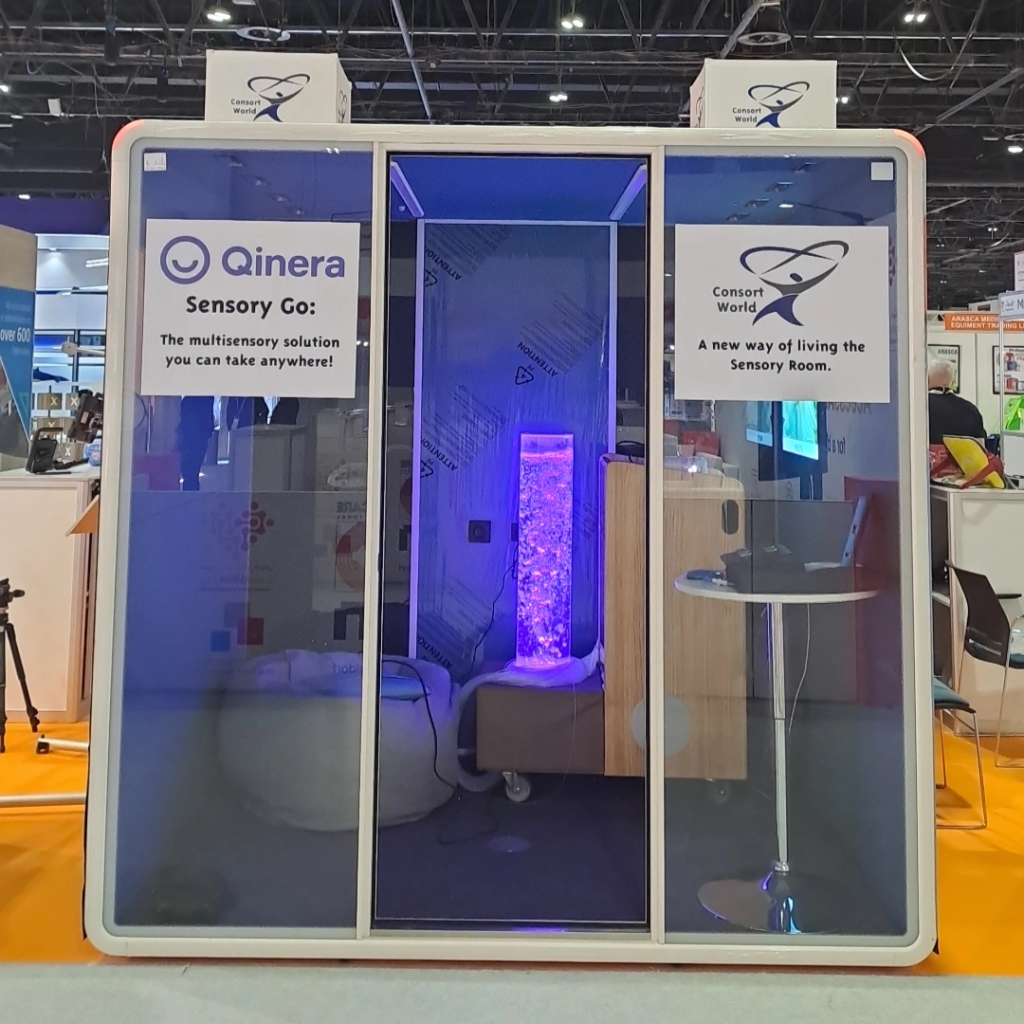Can you imagine stepping into a cabin where the noise fades away, the lights shift into soothing colors, and your whole body and brain begin to relax?
It may sound futuristic — but it already exists.
Our partner Consort World, based in Dubai, created a multisensory cabin by integrating our Sensory Go SHX inside a compact therapeutic pod designed to offer calm, regulation and moments of connection or joy in spaces where a full multisensory room isn’t possible.
The concept is intended for children, teenagers and adults who benefit from predictable, low-stimulus environments — especially neurodivergent people who experience sound, light or movement intensely. In schools, clinics, cultural spaces and other settings with limited space, the cabin provides a contained environment where overstimulation slows down and users can reconnect with calm, focus and emotional balance in just a few minutes.
What exactly is a multisensory cabin — and why is it so powerful for calm and regulation?

A multisensory cabin is a small, enclosed space designed to offer sensory safety and regulation in a controlled, private environment.
As Consort World explains:
“The idea behind the multisensory booth was to demonstrate that centers, schools, and hospitals don’t need a full dedicated sensory room to deliver high-quality sensory experiences. By installing a soundproof pod in any open space or atrium, they can immediately create a controlled, immersive environment without major renovations.”
The cabin offers enough room for a child and a therapist — or for an adult to enter alone or accompanied — while still being contained enough to reduce noise, bright light from busy environments and other unpredictable sensory input. The glass door keeps visibility and safeguarding, creating a protected space without feeling isolated.
By providing a predictable, low-stimulus atmosphere, it reduces sensory overload quickly and helps the nervous system settle — making users more open to connection, communication and therapeutic activities.

What makes the cabin interactive and immersive?
Inside the cabin is a complete Sensory Go SHX — a portable multisensory cart that transforms any space into a therapeutic, wellness or recreational environment. It includes a bubble tube, fiber optics, a vibroacoustic cushion, a projector, integrated audio and a tablet preloaded with scenes and interactive activities.
Qinera’s SHX technology is what makes the cabin truly interactive. With just the press of a button, the entire environment shifts in harmony: lighting, sound, vibration, projection and every sensory element transform at once, creating immersive scenes that feel responsive and alive.
“Qinera’s SHX technology is a core part of the booth’s functionality,” Consort World explained.
“By integrating SHX inside the pod, we turn a compact space into a fully coordinated multisensory environment controlled from a single interface.”

Every scene can be customized by therapists, teachers or by the person using the space. This means the cabin adapts to the sensory and emotional needs of each user. You can create your own content, personalise each activity and offer multiple ways to interact — using the SHX tablet, Button 6, Button 1 or SHX Proximity.
In spaces like airports or shopping malls, this flexibility allows staff to load scenes that reduce sensory overload quickly, guide users toward calm or create familiar, predictable environments that help them navigate overwhelming moments with more ease.
The cabin can also evolve over time. In the Consort World setup, they added a vibroacoustic pouf — which quickly became one of the most grounding elements, offering a comfortable place to sit while exploring the bubble tube and the fiber optics.
A space that supports emotional wellbeing in schools
By reducing sensory input and offering a predictable environment, the cabin helps users return to a balanced state where they feel safe and emotionally grounded. Once regulated, they can re-engage with learning, communication and social interaction with much more ease.
“These spaces help students regulate, making it easier to calm down or refocus. They also promote inclusion by supporting students with different sensory needs in a respectful, accessible way.”
And because the Sensory Go SHX is fully portable, schools can also use it outside the cabin — in classrooms, therapy rooms or any available space — extending sensory support throughout the school day and making regulation possible wherever it’s needed.

Consort World sees multisensory environments as essential for the future of education and accessibility:
“Multisensory environments will play a growing role in supporting inclusion and emotional wellbeing. They give individuals of all sensory profiles a place to regulate, connect, and participate more fully”.
At Qinera, we share the same vision: a future where every person can feel safe, emotionally supported and free to participate in their environment with confidence.
Who else can benefit from a multisensory cabin?
Although the concept began with schools that don’t have space for a full sensory room, the cabin with Sensory Go SHX can support users in many environments where overstimulation is common:
- Mainstream schools: a calming space that helps students reset and return to learning.
- Special education schools: a predictable sensory space for therapy and structured sessions.
- Hospitals: a quiet, contained area that reduces medical anxiety and supports waiting periods.
- Airports: a predictable space for travellers experiencing sensory overload.
- Shopping malls: a supportive corner that creates breathing room in overstimulating spaces.
- Companies: a wellbeing space for employees to decompress and refocus.
- Museums and libraries: a calm zone to regulate before re-engaging with the space.
- Public spaces: a small refuge for anyone experiencing sensory overwhelm.
Free Project Design
If you want to learn more about the benefits of Multisensory Environments or see how you could adapt it to your space, therapeutic goals, and users, you can send an email to hello@qinera.com.













